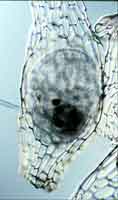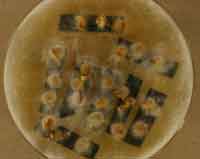Orchid Conservation
North American Orchid Conservation Center (NAOCC)
In nature, orchids depend on mycorrhizal fungi for seed germination and to provide a source of energy.

Corallorhiza maculata
(courtesy RS Currah)
Approximately 250 species of native orchids occur in North America. Almost half of these species are under severe threat due to habitat destruction and many species are likely to become extinct unless action is taken soon to conserve them and their fungal partners.
In recognition of this problem, the North American Center for Conservation of Native Orchids (NAOCC) was established by the Smithsonian Environmental Research Center (Edgewater, MD) and the United States Botanic Garden (Washington, D.C.). Two meetings (June 25-26, 2012 and Mar 24-25, 2014) have brought together representatives from several botanic gardens, seed repositories and fungal culture banks.
A major goal of the NAOCC is to enhance knowledge of orchid biology. A newly developed interactive website, Go orchids, offers a mechanism to identify and learn about the features of North American native orchids. Other goals are to establish seed and fungal banks that represent the broad genetic diversity of both partners, to develop protocols for propagation and restoration of native orchids, and to promote habitat conservation and restoration through partnerships with landowners and societies.

Germinating orchid seed
(courtesy RS Currah)
Current partners include the Smithsonian Environmental Research Center, the Smithsonian Gardens, the National Museum of Natural History, the National Zoological Park, the National Museum of the American Indian, the United States Botanic Garden, Alaska Botanical Garden, Atlanta Botanical Garden, Chicago Botanic Garden, Desert Botanical Garden, the Microfungus Collection and Herbarium, Illinois College, The Center for Plant Conservation, New England Wild Flower Society, The Nature Conservancy, Bureau of Land Management, Mt. Cuba Center Inc., Duke Farms. Collaborations with other agencies and organizations that work with, or are responsible for, conservation and management of native orchid populations are envisaged.
Learn more about the NAOCC and orchid science. View video or brochure.
Conserving orchid fungi at the UAMH

Our role with the NAOCC is to conserve the genetic diversity of orchid mycorrhizal fungi. The UAMH bank of orchid mycorrhizal fungi (see list) is an invaluable resource established over many years of research work by R.S. Currah (University of Alberta), L.W. Zettler (Illinois College, Jacksonville, IL) and others. The research of L.W. Zettler focuses on conservation of threatened orchids and the symbiotic germination of orchid seed with host-specific and locally adapted mycorrhizal fungi. Approximately 70 isolates have been demonstrated to initiate symbiotic seed germination in vitro (See Zettler et al 2011, Keel et al 2011). In 2013, 51 isolates were received for deposit and included Ceratorhiza and Epulorhiza species obtained from rare or endangered orchid species. These added to the 250 isolates orchid mycorrhizal fungi already accessioned. Over 50 isolates held in UAMH are derived from the U.S. Federally threatened eastern prairie fringed orchid Platanthera leucophaea.
For more on the role of the UAMH in conservation of orchid fungi see Sigler NAOCC presentation (pdf).
 Cryopreservation or freezing in liquid nitrogen (LN) is the method of choice for long-term storage of nonsporulating fungi, but a number of variables can affect recovery including the fungal species, the cryoprotectant, the age of the culture and possible presence of staling compounds. Among the most difficult to preserve are some ecto- and orchid mycorrhizal fungi. Based on a report by Stielow JB et al (Mycologia 2012; 104:324-330) who described improved recovery from freezing when isolates were grown on charcoal filter paper, we have conducted trials on several ectomycorrhizal and orchid mycorrhizal fungi that had previously failed to survive LN or gave very poor recovery in multiple preservation attempts. Results to date indicate higher rates of recovery for both groups of fungi and optimum results when the filter paper is well colonized. The method is more labor intensive and time consuming than our usual method using straws, but appears to be of value for preserving important orchid and ectomycorrhizal fungi.
Cryopreservation or freezing in liquid nitrogen (LN) is the method of choice for long-term storage of nonsporulating fungi, but a number of variables can affect recovery including the fungal species, the cryoprotectant, the age of the culture and possible presence of staling compounds. Among the most difficult to preserve are some ecto- and orchid mycorrhizal fungi. Based on a report by Stielow JB et al (Mycologia 2012; 104:324-330) who described improved recovery from freezing when isolates were grown on charcoal filter paper, we have conducted trials on several ectomycorrhizal and orchid mycorrhizal fungi that had previously failed to survive LN or gave very poor recovery in multiple preservation attempts. Results to date indicate higher rates of recovery for both groups of fungi and optimum results when the filter paper is well colonized. The method is more labor intensive and time consuming than our usual method using straws, but appears to be of value for preserving important orchid and ectomycorrhizal fungi.